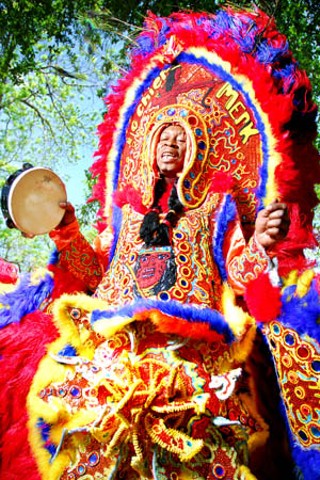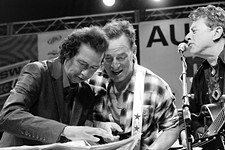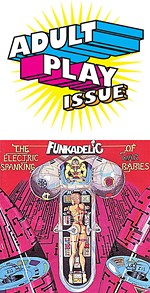My Gang Don't Bow Down
Mardi Gras Indian Chief Kevin Goodman leads his tribe to Texas
By Margaret Moser, Fri., May 5, 2006

Big Chief's deconstructed headdress lies on the bare cement floor of a nearly empty garage in Southeast Austin like a half-finished elementary school project.
A large semicircle of light green poster board reinforced by a smaller half-circle rises above the cutout for the face. Below that, tabs taper under for the chin, then curve over the shoulders. Strips of brightly colored material once glued to it are now torn away. A few sequins and downy wisps from its previous incarnation dot the structure. A paper design of a bull's head with detailed scrolling newly adorns the center of the headpiece.
"It might be a longhorn," offers Kevin Goodman with a playful grin, gold-capped teeth standing out against his burnished skin. The handful of fiery orange feathers in his hand fan into a half-moon. "You use really long ones here," he explains, holding them to the top of the structure. In the imagination, plumes extend four or more feet into the air in a brilliant, waving halo.
Goodman is so wrapped up in the design process that his forehead is once again smooth, in contrast to the anger that furrowed it 10 minutes earlier. Amid his pride in relating the story of life as big chief of the Flaming Arrows Mardi Gras Indian tribe in New Orleans and the secrets of "masking Indian," he angrily spun a horrifying tale of survival after Hurricane Katrina.
Wading out of the rising waters in his neighborhood on August 29 after the levees broke, babies and little children in his arms, he and his family sought shelter in New Orleans' Convention Center. They suffered four godforsaken days without food, water, toilets, and electricity amid relentless summer heat.
When Goodman and his family finally evacuated New Orleans, he landed at the Austin Convention Center. Met with compassion and open arms, he chose to stay and begin his life anew. The rich detailing of New Orleans' centuries-old history is far more intricate than Austin's relatively new one, yet the two towns have long shared an affinity for each other's music. Goodman is grateful for the generosity.
Yet this is no fairy tale ending. New Orleans and its levees are ill-prepared for the hurricane season that begins June 1. Uncertainty fogs the future of his hometown and unanswered questions abound for thousands of New Orleanians displaced throughout the country. For Kevin Goodman, his status as big chief is evidence of revered tradition, his home's troubled past, and a chance to start over.
My Flag Boy and Your Flag Boy
To the outsider, the notion of blacks in Native American tribal dress is anachronistic. How did slaves, shackled and shipped into America from Africa and the Caribbean, come to adopt Indian garb?
Popular doctrine is a variation on "my enemy's enemy is my friend," that native Louisiana tribes sheltered runaway slaves. Another theory suggests that Buffalo Bill's traveling Wild West Show inspired imitation of native rituals. Either way, present day styles are more Hollywood than Plains Indian, whose resplendent headdresses originally inspired the Mardi Gras Indians. Costuming is called "masking," dressing in tribal costumes for the purposes of marching, as they do on Mardi Gras and St. Joseph's Day.
Segregated from the white Carnival krewes, the Mardi Gras Indians began parading in the late 1800s. On an offbeat path few tourists see and through mostly black settlements in New Orleans, they took on names that often identified them by neighborhood. The names are exciting, evocative, and colorful (see "Tribes" sidebar): 9th Ward Hunters, Creole Wild West, Young Cheyenne, Golden Eagles.
The purpose of masking is to show off the extravagant costumes with enormous headdresses, or "crowns." Elaborate protocol sets the stage for peacock-like preening of feathered finery and sparkling stitchery when the chiefs meet. Tribal positions such as "spy boy," "flag boy," "trail chief," and "wild man" lead the parade of colors and relay information about approaching tribes with hand signals, calls, whoops, and dance steps. Like the battlefield often cited in their chants, the tribes face off, big chiefs strutting and swaggering until one acknowledges the other as the "prettiest."
Goodman grew up in the 7th Ward, where Frenchmen Street crosses North Rocheblave. That's the "back o' town, near Tootie Montana," he says, proudly citing the late big chief of the Yellow Pocahontas tribe as a neighbor. Back of town is also where Goodman inherited his crown from his father, Big Chief Merk, who left the Medallion Hunters tribe to establish the Flaming Arrows in 1963. Tribes rise into prominence, then fall into history. They also shift and regroup every few years, such as when jazz saxophonist Donald Harrison left Guardians of the Flame tribe, where his father was big chief, and formed the Congo Nation.
The accompanying chants, sing-song patois, and funky rhythms spring from Haitian and African music, not Native American music. The ubiquitous "Iko Iko," charted nationally by the Dixie Cups in 1965, remains perennial; few outside New Orleans recognized the counting-rhyme cadence of "my flag boy told your flag boy I'm gonna set your flag on fire" as tribal code. The Wild Tchoupitoulas' "Meet de Boys on de Battlefront" and the Wild Magnolias' "Handa Wanda (Pts 1 & 2)" match "Hey Pocky Way" and "Shoo Fly" as Indian classics. The annual New Orleans Jazz & Heritage Festival, which continues this weekend, provides the highest profile for the Mardi Gras Indian gangs, who conduct "walk-around" parades. Goodman is visibly annoyed by the contemporary image of Mardi Gras, the Bourbon Street bacchanalia imitated annually on Sixth Street in Austin.
"To tourists, Mardi Gras is 'throw parades' with the beads and floats and people getting drunk and showing tits," he says. "Indian Mardi Gras is different. For us, it's Carnival. We mask for the people in our neighborhoods, the old people sitting on the porches. We sing 'Indian Red,' and the chief would call off the different positions, like spy boy, gang flag, flag boy, wild man – wild man's got horns on his head and a hatchet in his hand. He clears the path, makes sure the ones wearing the costumes get respect."
These symbolic showdowns mirror the once-bloody rivalries of the tribes who faced off on Fat Tuesday. Goodman has no time for such violence.
"'Kill 'em dead' means with needle and thread. You don't work to make beautiful costumes then go tear them up. You can't hang out in the streets, bars, clubs. You gotta buy sequins, pearls, beads, glue guns, material, cardboard. We take the gun from the hand and put a needle and thread in it."
Sew, Sew, Sew
"Everybody in the family and the neighborhood pitches in to sew," Goodman explains about the communal contributions and thousands of hours put into a "new suit." This is a bonding element for tribes and their families. Creating the suit means countless hours of sewing, yes, but also provides an atmosphere in which oral history, dances, and sewing techniques are passed along.
"The songs have meaning, like 'Sew, Sew, Sew,' because on Mardi Gras you gotta look pretty," waves Goodman. "People look at those feathers! We sew for the beauty of seeing it finished. When you put the costumes on and people see it, their eyes are as big as half-dollars."

The family, relatives, neighbors, and anyone who feels like it can fall into place behind the Indians. They sing, bang tambourines, dance, twirl umbrellas, and form the famous "second line." The second line is one of New Orleans' most beloved traditions, appearing not only at Mardi Gras and St. Joseph's Day parades but at funerals as well.
Though the crown is the memorable feature of the costume, the "patches," chestpiece, and "apron" command attention, displaying intricate beadwork and eye-popping sequin patterns. Buffalo, spears, eagles, warriors, and other tribal motifs are integrated into the design. These are neither cheap nor quick to produce, and every year requires a new look. Each tribe has a specific style of sewing and the results are dazzling to behold.
"The pattern can be traced over and over, 30 times, as many times as you need it," relates Goodman. "I might take the top part and use it on different parts of the costume. The crown has a wire on the back of it before it's decorated. It'll weigh about 14 pounds, but you carry the weight on your shoulders. The crown will have a band to hold it on your head."
The cardboard bones of the crown are covered in canvas and designs drawn on it. The feathers are arranged with glue, then stitched to the cardboard. Emblems meaningful to the various tribes are prominent; in this case, a flaming arrow.
"I think my dad chose the name from the Bible, when God sent the flaming arrow at Adam and Eve after she ate the apple. Fire is beautiful, but it destroys."
The Mardi Gras Indian tradition showed no signs of being destroyed until late last August. "I heard the hurricane was coming, but we hear that a million times," reflects Goodman. "You get a good hard rain in New Orleans, and it will flood anyway 'cause of the drainage system."
When the Levee Breaks
"I watched the storm from my front door," begins Goodman. "Katrina came and then she was gone. When it was over, the sun came out. Then the levee broke, or was blown up."
Goodman's casual reference echoes a horrifying but widespread rumor among many flood victims: That the levee along New Orleans' Industrial Canal was blown, maybe dynamited, on purpose.
"Whether the levee broke or was blown up, the water came, and it came in one direction: toward the 9th Ward.
"It was me, my brother, his daughter Precious, and a young lady with baby twins and two kids. We tried to leave one way for higher ground, but the water was rising so we had to turn around. The water was filthy. We're walking through tree limbs, cable wire, stuff grabbing our legs. Precious had an operation about six months before. She got meningitis from that water and is still in a hospital in Dallas. We floated the kids on a door and got to stay at St. Augustine School.
"Some guys in the neighborhood had boats the next day and took us to the foot of the bridge. People were sitting all along the bridge with everything they could carry. We walked from there to the Convention Center. It felt like 120 degrees in the heat. We cut a piece of carpet for the babies and laid down. Five minutes later, a stampede of people started toward us 'cause they heard the buses were coming. People started to pile up, hundreds. They kept saying, 'The buses gonna come,' but they didn't. Day after day. We never saw no officials or city leaders. We might have been satisfied to see someone in a suit and tie.
"I was at the [New Orleans] Convention Center three, four days without food. People sick, sitting out on the curb in their wheelchairs, using the bathroom on themselves. Babies dehydrated. No nurses, no medical attention, no doctors. By Friday night I was laying down trying to sleep, but I couldn't stand the smell of myself or the filth around me. So I got up and walked around. I saw a police car go by and some guys started walking toward the police car. One guy's trying to get their attention, and he waved like this. Next thing I know I hear, 'Boom!' A shot come out of the police car and they drove off. Killed a man and left him. Gone. Everyone watched him die, gasping for breath. I bet it didn't get reported, that the police killed a man. I never seen nobody die before.
"The police cars say, 'Protect and Serve.' Wasn't no protecting and serving going on. We protected ourselves and served ourselves. The sick, the poor, the helpless. About 2 hours later, the police passed by again and ran over the dead man they killed. And kept going. I raise my right hand to God."
The wounded words falter from a chief who did his best to protect his tribe and couldn't.
"I couldn't take it no more."
Big Chief Got a Golden Crown
Kevin Goodman reaches for the bright orange feathers and a faint breeze in the garage ruffles them in his fingers. If a helicopter could transport him from New Orleans' devastation and send him on a chartered flight to Austin, he could uproot pageantry deeply embedded in the culture of the Delta and bring it to heart of Texas. He'd never heard of Austin, much less knew where it was.
In Austin, Kevin Bush is his new second chief, someday to wear the big chief crown. Bush sits in a wheelchair; his own story of lashing himself to an attic rafter with a rope to escape the floodwaters is bone-chilling. Annie Jenkins, another evacuee, is Goodman's new queen, soon to be mother to their child. His children are learning the ways of the tribe as the Young Flaming Arrows. The hurricane took a lethal toll on the Mardi Gras Indians, yet come next Mardi Gras, they'll all have another costume, glittering and regal.
Goodman goes to therapy weekly "to work out a lot of stuff." In seven months, he's performed around town on New Year's Eve, at Antone's, Jovita's, the airport, local festivals, SXSW, and marched through the Rosewood neighborhood. He toured India, Sri Lanka, and the United Arab Emirates, sponsored by the Lincoln Center. Impressed by native Sri Lankan art, he's busy building a mask inspired by the visit. His newly adopted home has renewed interest in the Flaming Arrows' funky, wonderfully percussive 1997 CD Here Come the Indians Now! This weekend, he returns to New Orleans to perform at Jazz Fest.
Goodman lifts the poster-board structure of the headpiece, the Chief's crown, onto his lap. His eyes fix on it, seeing its future, rainbow-hued glory. Its mojo is intact. There's undeniable irony to this process, that from such rudimentary beginnings come such a fiery display of pride. Though he lost a lifetime of costume history to the elements, two of his suits were preserved in a New Orleans museum exhibit. Back in his hands, they've given him a starting point, 500 miles from his home, a triumph of spirit over circumstance.
"We just want to keep the New Orleans spirit alive. Keep the flame going." ![]()








